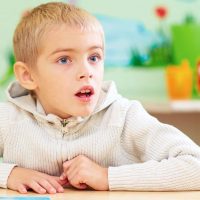Anxiety
-
Adult ABMT protocols need adapting for effective use in children
Attention bias modification treatment (ABMT) aims to target attention biases in threat processing in patients with anxiety1. While ABMT seems to be effective in adults with social anxiety disorder (SAD),2,3 its effect in youths with SAD and the potential treatment moderators are unclear. In 2016, Lee Pergamin-Hight and colleagues conducted a randomised controlled trial to explore the efficacy of ABMT in youths and the influence of possible moderators of treatment outcomes.
Read more -

Parent-led group CBT training can reduce anxiety in children
A brief psychological intervention in which parents and carers are supported in applying cognitive behavioural therapy (CBT) principles in their child’s day-to-day life can lead to good outcomes for child anxiety disorders, according to new research.
Read more -

FRIENDS programme reduced anxiety, but has no effect on school academic performance
Professor Paul Stallard and colleagues have analysed data from the randomised controlled trial “Preventing Anxiety in Children through Education in Schools” that involved >1,300 children aged 9-10 years from 40 primary schools across England.
Read more -

MEG confirms hyper-vigilance followed by threat avoidance in children with anxiety disorder
A key etiological factor of anxiety disorders is an altered pattern of threat processing, but its neurobiological basis is relatively unclear.
Read more -

Meta-analysis of secondary anxiety prevention
Dr Peter Lawrence summarises the paper ‘Prevention of anxiety among at-risk children and adolescents – a systematic review and meta-analysis’
Read more -

Children with a Specific Phobia do better in Individual CBT than Group CBT and guided parent-led CBT
Children often present to health care settings with highly impairing and disabling anxiety disorders, including Specific Phobia, Social Anxiety Disorder, Generalised Anxiety Disorder and Separation Anxiety Disorder.
Read more -

Negative interpretation bias in adolescents with subclinical social anxiety disorder
Social Anxiety Disorder (SAD) is a marked fear or anxiety of social situations where an individual may be exposed to possible scrutiny by others. Now, Yura Loscalzo and colleagues have examined the contribution of different components of interpretation bias — a model proposed to explain SAD whereby affected individuals systematically assign a threatening meaning to an objectively ambiguous stimulus with several possible interpretations.
Read more -

The overlap between low self-esteem and anxiety/depression in CAMHS
Our systematic review aimed to establish what is known about low self-esteem and anxiety/depression in young people (<18s). We wanted to find out whether young people with clinically significant anxiety disorders and/or depression also have low self-esteem as measured on validated questionnaires. We also wanted to know whether young people with low self-esteem as measured on a validated questionnaire develop depression and anxiety symptomology later in adolescence and young adulthood.
Read more -

Can this app help autistic people with anxiety?
Available on the Apple App Store today, Molehill Mountain is the first evidence-led smartphone app aiming to help autistic adults understand and self-manage their own anxiety. The app has been developed by UK research charity Autistica and researchers at King’s College London with input from autistic people.
Read more -

Talking therapies and adapting for autism
Dr Ann Ozsivadjian is a clinical psychologist who specialises in making talking therapies work for children with autism. Her job at Evelina London Children’s Hospital, Guy’s and St Thomas’ NHS Foundation Trust, was created at the request of the parents of autistic children, who were having trouble with conventional talking therapies. “Accessing therapy can be […]
Read more